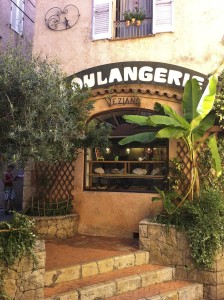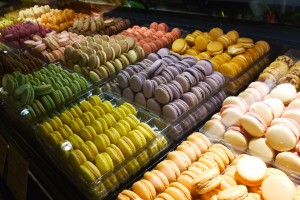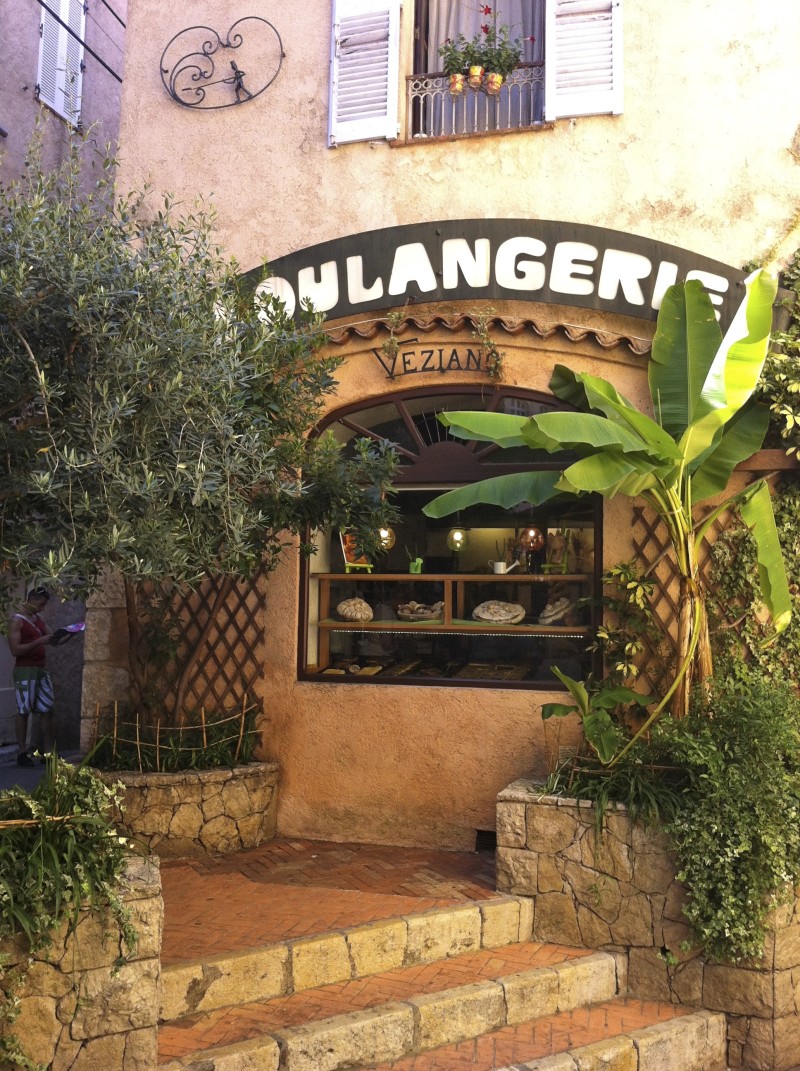Il y avait très peu à manger, Arlette says, her voice bearing the gentle crackle of a woman in her mid-80s. There was very little to eat back then. Each day my parents put little tickets on the bread with our names on them – there was one baguette in the house each day – and these tickets showed how much each of us was allowed to eat.
My friend, a delicate woman with fine bones and a girlish smile, would’ve shared the daily baguette with her parents and three siblings. She places a thumb and forefinger at the edge of the garden table between us and measures out about four inches. That was the size of her daily nub.

Arlette time-travels in this way because I’ve asked for these details – any details she can remember. Each one is relevant, a precious key into a world I’ve been working to unlock for years. The memories that flit back into her mind happened decades – no, generations – ago. It was Antibes, our summer hometown, in the early 1940s. The beginning of the dark years. The war years.
What makes the memory about the baguette particularly intriguing to me is that when Arlette was a 10-year old with two blond braids, she lived in our home, Bellevue. How we discovered each other is in itself a story, but suffice to say that a few years ago I was trying to contact her husband Jean, an area historian and a marvelous storyteller with his own links to the house, and I ended up finding her, too.
When Philippe, our daughter Lolo and I first arrive at Jean and Arlette’s home this early evening, Jean delights in handing me a couple more visions of yesteryear. I’m probably even more delighted to accept them. This robust man with a ruddy complexion and head of white hair continues to dig up clues for me. These latest finds come from a cousin’s home. He produces a white envelope as the five of us gather in the garden, a neat square of land sectioned off within a larger, storied estate.
The air is enticingly cool, lacking all the oppressive heat that has plagued the Côte d’Azur this summer. Our hosts have scattered bottles and cartons over their patio table – a rainbow of juices and syrups, sparkling waters and beers and Jean’s favourite, whiskey. At the end of the table Lolo gulps her strawberry juice in a bid to refill her glass with Perrier and a dash of cherry syrup like mine. She sneaks longing looks at the novel and iPad on the table beside her.

The first photo from Jean’s envelope shows a bearded Edouard Muterse, the man who built our Bellevue, steering his state-of-the-art vessel with two oversized, white sails. We’re peering together into the 1930s, I surmise, off the coastline of what’s now Antibes’ busy Port Vauban. The other photo must predate the first by a decade. Edouard’s father and sister stand in separate, stiffly staged positions in front of Le Bosquet, the main home occupying the family estate where we sit this evening. The woman in the photo is Jean’s grandmother.
Arlette places a platter of dainty finger sandwiches beside the forest of bottles – a generous assortment of bite-sized pans bagnats, and colourful club sandwich triangles with their crusts cut off.

I turn to Lolo. Now might be a good time to ask Mme Aussel la question, I say. My 10-year old agrees, probably because this could be her participation, done and dusted. Grown-ups can talk forever. We already agreed to the book-and-iPad arrangement – in fact, I suggested it – as long as she first took part in the conversation.
La question arose on the way to Jean and Arlette’s home. You know what would be interesting, I said to Lolo. Mme Aussel was 10-years old when she lived in our house. Just like you are – except back then it was wartime. Why don’t you ask her what she did for fun when she was your age living in the very same house? You could compare – see what has changed and what has stayed the same.
Lolo considered la question silently at first and then began offering her favourite things to do at Bellevue. I took it as implicit agreement.
I like to swim in the pool, she said. And I like to colour mandalas and play on my iPad. And I like to take windsurfing lessons. (While not technically at home, the lessons do take place from the neighbouring beach.)
So Lolo is armed with a question that is at least moderately appealing to her. More importantly, this question eventually will release her to more interesting things.
Jean and Philippe tie up their own conversation as I frame la question for Arlette. What did she do for fun when she was 10-years old living in Bellevue?
Arlette searches her memory. She’s a little stumped.
It was during la guerre, she says. The war. Her voice is gentle and searching. I went to school, l’École d’Antibes, on foot each day with my sister. Nous avons beaucoup marché, she says. We walked a lot. We made that trip four times a day including a return trip at lunchtime.
I do some quick math. Antibes’ school was in the old town. The young Arlette spent nearly an hour and a half each day walking to and from school! But what about fun? I ask. Did you play des jeux – games?
The salle de jeux was downstairs, Arlette says. She describes a room inside Bellevue that’s close to the water’s edge. Today that room is a guest room. I try to envisage the former décor – a lush, vibrantly coloured rug, perhaps, with rows of shelving heaped in games.
Arlette says she did her homework in the so-called game room. It’s a simple statement, hardly a reflection about meager circumstances.
Pas de coloriage? De jeux de société? I ask again. No coloring? Board games?
Lolo stops nibbling at the ham slices she has removed from her sandwich triangle. She has been listening to the conversation, fortunately with some interest. Like for me, she says to urge on our family friend, I like to colour and swim and windsurf.
Arlette’s face brightens at these ideas. For fun, she says, j’ai pêché des crevettes. She fished for little shrimps. She went out into the garden. She climbed on the rocks at the seaside and swam.
The two 10-year olds – mine, and the one in Arlette’s memory – found seeds of connection. They both enjoyed the garden. They both swam. I like to think Lolo’s delight in this affiliation might not even involve the growing proximity of iPad time.
The opportunity to sit here in Jean and Arlette’s garden is alone a gratifying experience for me. Their home, La Serre (The Greenhouse), lies so close to Le Bosquet that the two homes are nearly connected. In his day Edouard Muterse used La Serre as a greenhouse for his collection of succulent plants. Meanwhile, on the other side of a hedge tonight, conversation pops from outside Le Bosquet. The villa is now the home of Jean and Arlette’s son, who runs it as a chambre d’hôte. Relaxing here – with this couple, and on this estate – is a bit like coming home.
Our conversation has morphed from vague images of childhood amusements to more vivid recollections involving food. I’m dazzled by Arlette’s memory about the baguette, a story she never has mentioned to me.
Of all the memories you’ve shared over the years, I say, many of your favourites have been about food. One time you told me about shucking peas with your sister outside on Bellevue’s balcony, I remind her. You said you were happy then. We thought of you earlier this summer, in fact, when Lolo’s nine-year-old cousin was visiting and she offered to shuck a pile of peas for me. I told the cousin that she was reenacting Bellevue’s history.
Arlette nods. Her blue eyes smile along with the rest of her face. She remembers.
Another time, I say, you mentioned the figs and carrots you stole. You took them right here from this estate!

Indeed, when Arlette was that young girl with blond braids, she was a member of the Guides, France’s Girl Scouts, and their troop meetings took place here, on the premises of Le Bosquet under the patronage of Edouard Muterse. It was one of my earliest points of connection with Arlette as I began researching the story of the man who built our house. Arlette was so hungry during the war that this well-mannered young girl stole figs off the estate’s trees and carrots from its garden – even if she suspected Mr Muterse knew all along.
I ate des carottes rapées for breakfast, she says. Grated carrots – with a bit of the baguette.
One time, she remembers for us now, she tried to steal a pomme from some friends. She and her family were guests at their home when she saw the apples. Arlette put one in her underwear. When she returned home, she reached to hang up her jacket – and the pomme tumbled out of her garments. Her parents saw it and sent her to her room for the entire day.
Lolo listens with such intent to this story about the pomme that the next day, I admit to asking her help clarify the details. As for colouring books and board games, I’ll realise that Arlette’s family had travelled to Antibes in order to escape the war in their native north. Children’s toys hardly would’ve qualified as essentials to cart on the way south.

After some time I give Lolo the all clear. She can slip away and let the adults talk. The four of us remain in the garden as the light grows dim. We sip our drinks and do honour to the fancy sandwiches and a box of sugary macarons we brought from town, treats that tonight we all appreciate a little more than usual.
Back at Bellevue tonight, Lolo wonders what’s for dinner. She only picked at a sandwich piece during our visit to La Serre. I have her perch at the kitchen counter while I assemble a hodgepodge of Lolo-friendly items from the refrigerator. Only after my 10-year old begins to eat am I startled by the contents of her meal. Alongside a small cup of gazpacho, I’ve given Lolo a four-inch slice of baguette. To complement a couple sticks of Emmental cheese, she has a puddle of fig jam. And in a separate ramekin I’ve prepared one of her favourites: buttered peas.
When she has eaten it all, she asks, can I have some more baguette?
What a privilege it is that I can say ‘yes’.


Beautifully written. The personalities in this “episode” are so vibrant!
Thanks so much, Jen! A true compliment. Much appreciated. j
What an interesting Saturday morning read – especially back through the other Bellevue “history” post. Brings back memories of an afternoon bike ride with Philipe through the neighborhood. Is the old Aga Khans home that Rozetskin tore down still sitting like a rotting hulk?
Great to hear from you, Craig! Last summer the former Aga Khan home was still that rotting hulk – nicely stated – as the mairie put a stop-work order on it after all the permit contraventions. But guess what? The place is actually receiving its facelift as I type. Things do eventually change – if you wait long enough! j
I’m always fascinated and intrigued as your research unearths more pieces of the puzzle through such meaningful conversation. Enjoy your last few weeks. 🙂
Merci, Patricia! That is the joy of getting to know some truly wonderful local people here over the years! I feel so fortunate they offer these stories to share!
A touchingly descriptive anecdote of an ongoing history.
Thanks so much, Electa!